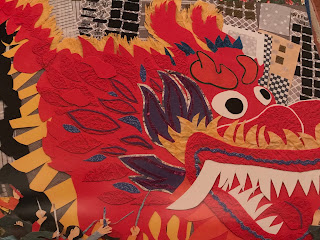Many Americans welcome the new year with parties, fireworks,
feasts and champagne at midnight. And what do we do the morning after? We make
lists of New Year’s resolutions. Do we keep them? Well, we try.
New Year’s Day is our once-a-year-day for a clean slate, yet
another chance to do better and be better. On New Year’s Day everyone is full
of good intentions.
Diets and exercise usually top the list, but really, lists
can go on and on and on: Read more good books, work harder, work longer, be
more polite, stop being impatient. No more bad words, go to sleep earlier, get
up earlier, hang up clothes instead of dropping them on the floor! Be better!
Be nicer! Be more generous! Be more appreciative! Be a better friend! Be a better
neighbor! Be tolerant, be understanding, be kind, be GOOD!
 |
| New Year's Eve in NYC, Illustration Susan L. Roth |
 |
| Chinese New Year, Illustration Susan L. Roth |
Once the list is begun, it can quickly fill the page, and
usually the list is adhered to, at the beginning, anyway. But what if we were
given a plethora of second chances for celebrations as well as for second
chances to improve ourselves?
Every Month is a New Year, (Lee and Low, 2017) a book of
poems by Marilyn Singer, illustrated by me, is a book full of Happy New Year
celebrations from all over the world. I learned so much from making the
pictures for this book: there are no two
even similar looking. And as for resolutions, every page turn affords a fresh
start.
 |
| Muslim New Year, Illustration Susan L. Roth |
Herewith I am presenting you with another big list full of
related activities for students, at least enough for an entire happy new year.
1-Ask students to write a short piece about the new year
celebrations that they enjoy in their own families.
2-Suggest that they create an accompanying illustration. My
favorite medium is collage, but they should choose their own favorite.
3-For the most energized, curious and adventurous students:
let them try to find other new year celebrations not mentioned in Every Month Is A New Year that they can
write about and illustrate.
4- Invite your group to make a joint project calendar of
happy new year illustrations which could certainly begin in February or March.
Pictures would not have to correspond with unusual-to-us month-specific
celebrations, but rather, personal ones. If there are more than a calendar
year's worth of students in your group, continue the calendar for as many
months as there are students. The finished product could be presented as a big
wall of illustrations as well as a calendar, designed to fill a bulletin board,
and/or it could be a consecutive band of illustrations designed to go around
the walls of a classroom.
5-Encourage each student to start his/her own list of
resolutions. Designate one day every month for looking back to see how they
did. Invite anyone who managed to keep his/her resolution for that month to give
a 30 second speech telling about it. Was it easy? hard? worth the effort? Does
the student feel proud and victorious? Take time for applause!
Do the same for anyone who wishes to tell about failing in
the attempt, with applause for the courage it takes to speak about the failure.
(This should be handled with humor).
6-Encourage a designated time, probably monthly, to look
into each of the cultures explored in Every
Month Is A New Year. The back matter in the book includes great
explanations and resources for each holiday.
For example: make a dragon; watch wheat grass grow fast daily, right
before everyone's very eyes, in a little dish in the classroom; make a kite and
fly it; eat green grapes. With permission and supervision, break pots. (Do skip
fireworks and firecrackers).
7-Maybe you could even create a brand new holiday: Happy New
Month! Let it include a short monthly LITTLE party, and don't forget the Happy
New Month's resolutions.
8-Finally, here are some heavier thoughts to think about,
write about, to illustrate.
Encourage everyone, including teachers and librarians, to
think about the concept and idea of starting new, starting over. Why is the
possibility of one more chance to BE better and to DO better so important? Does
hope REALLY spring eternal? And why do we have celebrations anyway? for
incentives? for rewards? just because they are fun?
I hope this food for thought gives you something to ponder
all year long.


No comments:
Post a Comment